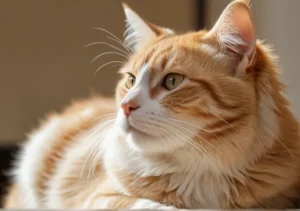Cats are beloved pets for many, but their dander can be a source of frustration for some. Have you ever wondered why cats get dander in the first place? Let’s explore the reasons behind this common issue.
Genetic Factors
Cats produce dander as a result of genetic factors that influence their skin and coat. Certain breeds, such as Siamese, Persian, and Sphynx cats are more predisposed to dander production due to their genetics. This is because these breeds may have oily skin or overactive sebaceous glands, leading to more dander being shed. It’s essential to consider these genetic factors when choosing a cat if you or someone in your household has allergies to dander.
Skin Health
Maintaining your cat’s skin health is crucial in reducing dander production. Regular grooming can help remove excess dander and distribute natural oils throughout the coat, promoting healthy skin. Additionally, providing a balanced diet rich in omega-3 fatty acids can improve your cat’s skin health, reducing the likelihood of excessive dander. Ensuring proper hydration is also essential for maintaining healthy skin and minimizing dander.
Tips for promoting good skin health in your feline friend include brushing their coat regularly, ensuring they are well-hydrated, and providing a nutritious diet. Regular visits to the vet can also help monitor your cat’s skin health and address any issues that may contribute to dander production.
- Regular grooming: Brush your cat’s coat to remove excess dander and distribute natural oils.
- Balanced diet: Feed your cat a diet rich in omega-3 fatty acids to promote healthy skin.
- Hydration: Ensure your cat has access to fresh water at all times to maintain skin health and reduce dander production.
For further information on cat skin health and dander production, you can refer to this helpful article from the American Veterinary Medical Association: AVMA – Cat Skin Health.
Allergies and Dander
Cat dander, which is a combination of skin cells and saliva, can trigger allergic reactions in some people. Allergies to cats are usually caused by proteins found in cat dander, and when you come into contact with it, it can lead to symptoms like sneezing, itching, and watery eyes. If you have a cat and suffer from allergies, there are ways to manage them while still enjoying the company of your feline friend. One approach is to designate certain areas of your home as off-limits to your cat, like your bedroom, to create a dander-free zone where you can find relief from your symptoms. Additionally, regularly cleaning your cat’s bedding, toys, and grooming them can help reduce the amount of dander in your living space. If your allergies persist, consider investing in an air purifier with a HEPA filter to capture airborne dander particles and improve your indoor air quality. Remember, a little extra TLC can go a long way in managing allergies caused by cat dander.
Grooming Habits
Regular grooming is essential to help reduce dander in cats and keep your home environment clean and dander-free. When it comes to grooming your cat, proper brushing techniques can make a significant difference in reducing dander production. Use a soft bristle brush and a metal comb to remove loose fur and dander effectively. Brush your cat at least twice a week to prevent mats and hairballs and to maintain their coat healthy and shiny. Bathing your cat occasionally can also help reduce dander and remove excess oils from their skin. Be sure to use a cat-specific shampoo and thoroughly rinse to avoid skin irritation. If your cat is not a fan of baths, you can opt for dander-reducing wipes to clean their coat gently. By adopting these grooming habits, you can effectively minimize dander production and create a more comfortable living environment for both you and your furry friend.
Grooming Tip: After brushing your cat, wipe them down with a damp cloth to collect any remaining loose fur and dander, keeping your home cleaner for longer.
Remember, effective grooming practices are key to reducing dander in cats and promoting a healthier living environment for you and your feline companion.
Environmental Factors
When it comes to cat dander, environmental factors play a key role in its production. Humidity levels and indoor air quality can significantly impact the amount of dander shed by your feline friend. High humidity levels can lead to increased dander production as it provides a conducive environment for dander to thrive. On the other hand, poor indoor air quality can also contribute to higher dander levels, as pollutants in the air can irritate your cat’s skin, prompting more shedding of dander.
To combat this, consider investing in a good quality air purifier to help improve indoor air quality and reduce the presence of dust and other particles that can aggravate dander production. Additionally, maintaining optimal humidity levels in your home can help keep dander at bay. Aim for a humidity level between 40-60% to create a less favorable environment for dander to accumulate. By optimizing these environmental factors, you can help minimize the amount of dander your cat produces, ultimately leading to a cleaner and more comfortable living space for both you and your furry companion.
Diet and Dander
Ever wondered why your cat seems to be shedding more dander than usual? Well, it turns out that their diet can have a significant impact on dander production. A diet lacking in essential nutrients can lead to dry skin in cats, which in turn can result in increased dander shedding. To combat this, consider incorporating omega-3 fatty acids into your cat’s diet, as these can help promote healthy skin and reduce dander production.
Additionally, ensuring your cat is properly hydrated is crucial for maintaining healthy skin and reducing dander. Make sure to provide fresh water at all times and consider adding wet food to their diet to increase their moisture intake. By paying attention to your cat’s diet and making necessary adjustments, you can help minimize dander production and keep your cat’s skin healthy and hydrated.
Dietary changes to reduce dander: 1. Add omega-3 fatty acids supplements to your cat’s diet. 2. Provide fresh water regularly to keep your cat hydrated. 3. Consider adding wet food to increase moisture intake for your cat.
Remember, a well-balanced diet is not only essential for your cat’s overall health but can also have a positive impact on dander production. By making small changes to their diet, you can help reduce the amount of dander shed by your feline friend.
Natural Remedies
If you’re looking to reduce cat dander in your home, there are some natural remedies you can try. One effective method is using an air purifier to help filter out allergens in the air. Additionally, keeping your home clean and dust-free can also help minimize dander. For a more DIY approach, you can try using a humidifier to add moisture to the air, as dry air can exacerbate dander production. Regularly grooming your cat and keeping their fur clean can also help reduce dander. Remember, a little maintenance can go a long way in keeping dander at bay.
And here’s a fun fact: Did you know that cats with darker coats tend to produce less dander than those with lighter coats? So if you’re looking for a new feline friend but are concerned about dander, you might want to consider a cat with a darker fur color. They could be a great option for those with allergies or sensitivities to dander.
Fun Fact: Cats with darker coats tend to produce less dander than those with lighter coats.
When it comes to shedding dander, the color of a cat’s coat can make a difference. Cats with darker fur tend to produce less dander than their lighter-colored counterparts. This interesting tidbit can be helpful to keep in mind if you’re considering adding a cat to your family but are worried about allergens in your home. By opting for a cat with a darker coat, you may be able to reduce the amount of dander in your living space. So, next time you’re choosing a new furry companion, keep this fun fact in mind for a potentially dander-reducing option.
Alex, a passionate animal lover, has experience in training and understanding animal behavior. As a proud pet parent to two dogs and three cats, he founded AnimalReport.net to share insights from animal experts and expand his knowledge of the animal kingdom.




